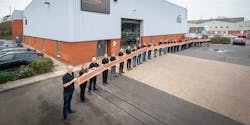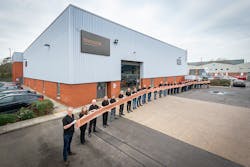Super-Long Flexible Printed Circuit Goes Outside the Board
If you’re not familiar with flexible printed circuits, or if your experience with them is limited to those which are folded (in some cases like origami) so they can squeeze into small enclosures, this one should change your perception. Trackwise (Tewkesbury, UK) has shipped a 26-meter (85 feet) long multilayer flexible printed circuit (FPC), believed to be the longest ever produced, for distributing power and control signals across the wings of a solar-powered, unmanned aerial vehicle (UAV) (see figure).
The entire power-and-signal-interconnect system of this UAV is made of FPCs, yielding an estimated total systems-weight saving of 60% over traditional wire harnesses. With the dramatic growth in UAVs of all sizes from tiny to extra-large vehicles or specialty versions, the use of FPCs in this particular class of applications is getting considerable attention.
This flexible printed circuit from UK-based Trackwise, which measures 26 meters (85 feet) long, is the main power/signal bus for a solar-powered UAV. The developer maintains that it’s the longest FPC ever produced.
Standard flexible printed circuits were developed over 50 years ago as replacements for wire harnesses to save weight and space. However, conventional FPCs are rarely more than one or two meters (three to six feet) long, primarily due to limitations of manufacturing processes. The Trackwise FPCs are manufactured using a patented, reel-to-reel manufacturing technique called Improved Harness Technology (IHT) that overcomes these limitations, enabling production of FPCs of unlimited length.
The flexible circuit is based on a polyimide substrate that withstands high temperatures. It’s possible to produce flexible circuits having a total thickness of less than 50 μm (0.002 in.), including a protective cover layer. Depending on application, the printed-circuit copper can be equivalent to standard 2-oz. cladding (2.75 mils/0.07 mm thick—or half that value for cladding on each side of a double-sided board on a rigid printed circuit board), with aluminum for lighter ground path.
In these applications, FPCs need fewer connection points, which enhances reliability. Furthermore, they’re easier to install than conventional wire harnesses, thus reducing assembly time and cost. FPCs also eliminate wiring errors that may occur with manual assembly of hand-built harnesses, because this “harness” floor plan is controlled by the design itself. Thus, it’s not possible to route circuits to points other than those designated by the circuit design and connection placement.
The planar structure of the FPC also dissipates heat more effectively than conventional wiring, enabling higher current-carrying capacity for a given weight of copper conductor. This is an important issue; for example, the National Electrical Code in the U.S. defines limits on even relatively low-voltage/power cabling such as PoE++ (IEEE 802.3bt) of approximately 100 W capacity per run. That’s due to the self-heating and heat build-up, which results from the limited dissipation when placed alongside or within other wires of a bundle in cable tray or plenum.
About the Author

Bill Schweber
Contributing Editor
Bill Schweber is an electronics engineer who has written three textbooks on electronic communications systems, as well as hundreds of technical articles, opinion columns, and product features. In past roles, he worked as a technical website manager for multiple topic-specific sites for EE Times, as well as both the Executive Editor and Analog Editor at EDN.
At Analog Devices Inc., Bill was in marketing communications (public relations). As a result, he has been on both sides of the technical PR function, presenting company products, stories, and messages to the media and also as the recipient of these.
Prior to the MarCom role at Analog, Bill was associate editor of their respected technical journal and worked in their product marketing and applications engineering groups. Before those roles, he was at Instron Corp., doing hands-on analog- and power-circuit design and systems integration for materials-testing machine controls.
Bill has an MSEE (Univ. of Mass) and BSEE (Columbia Univ.), is a Registered Professional Engineer, and holds an Advanced Class amateur radio license. He has also planned, written, and presented online courses on a variety of engineering topics, including MOSFET basics, ADC selection, and driving LEDs.


